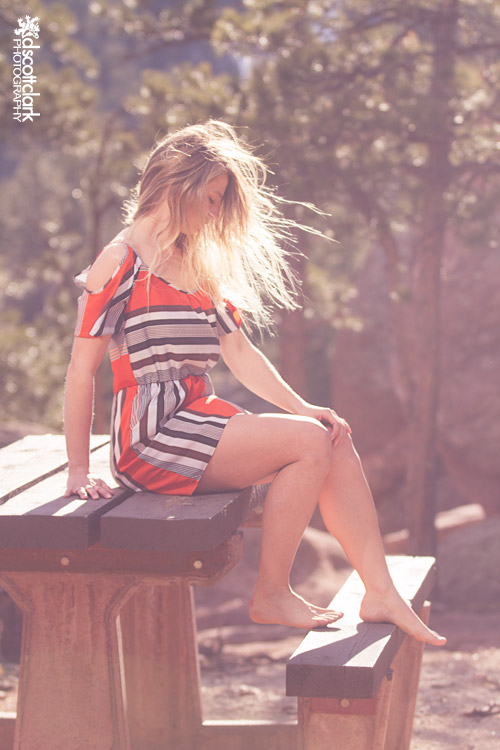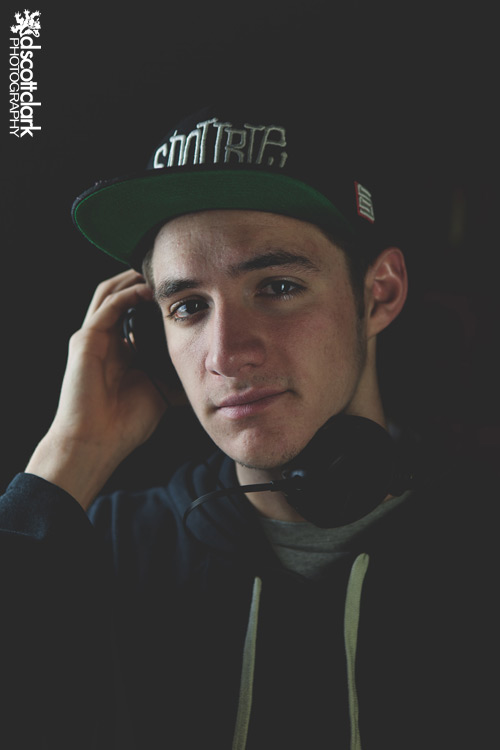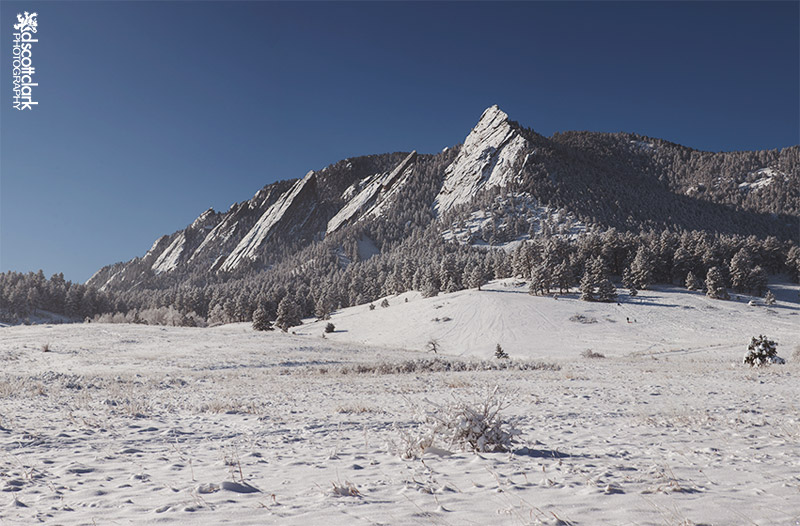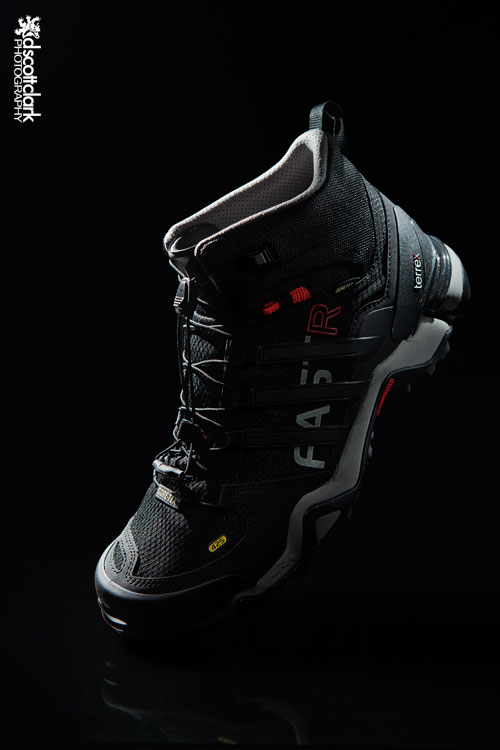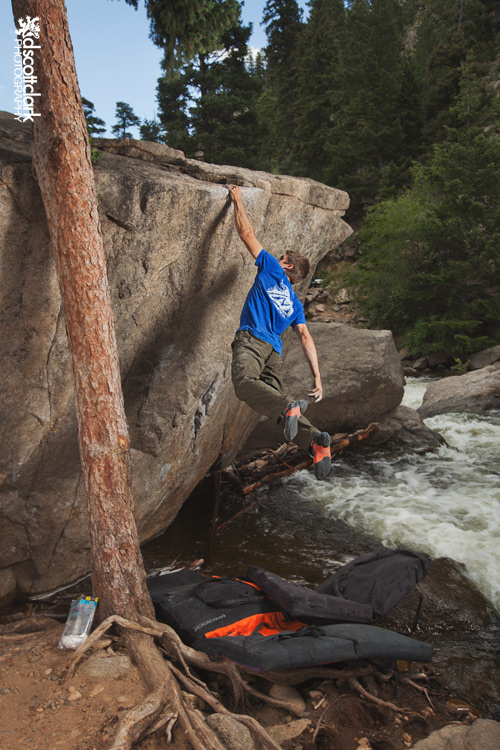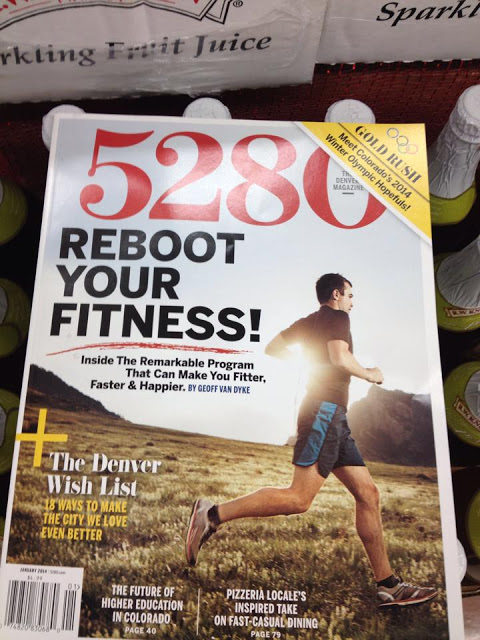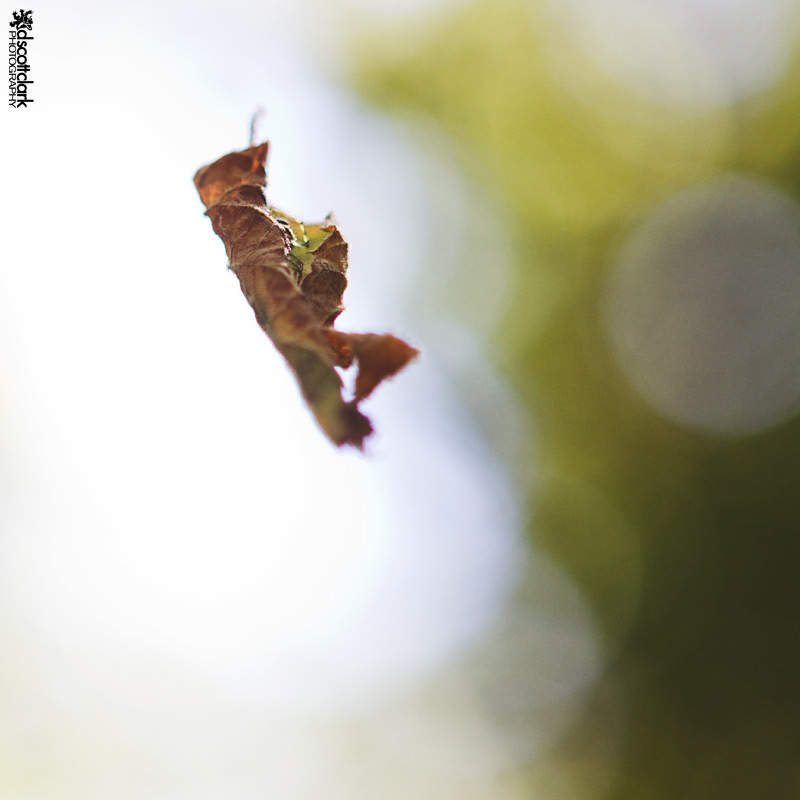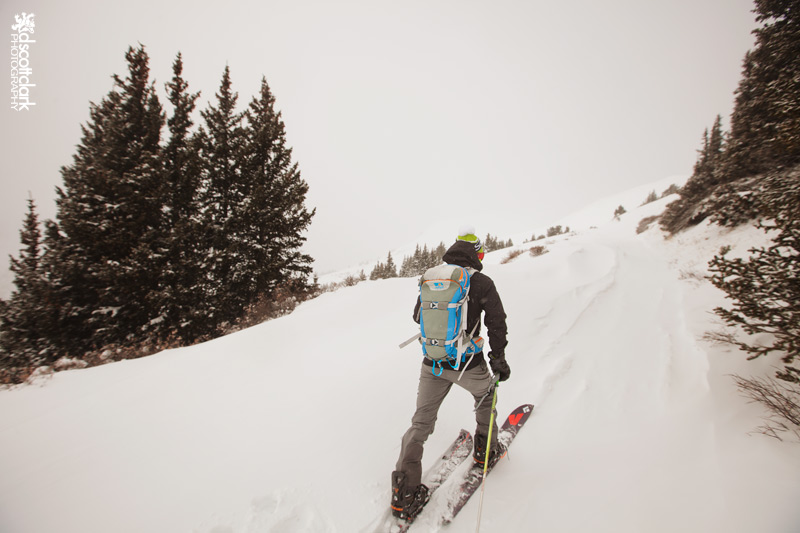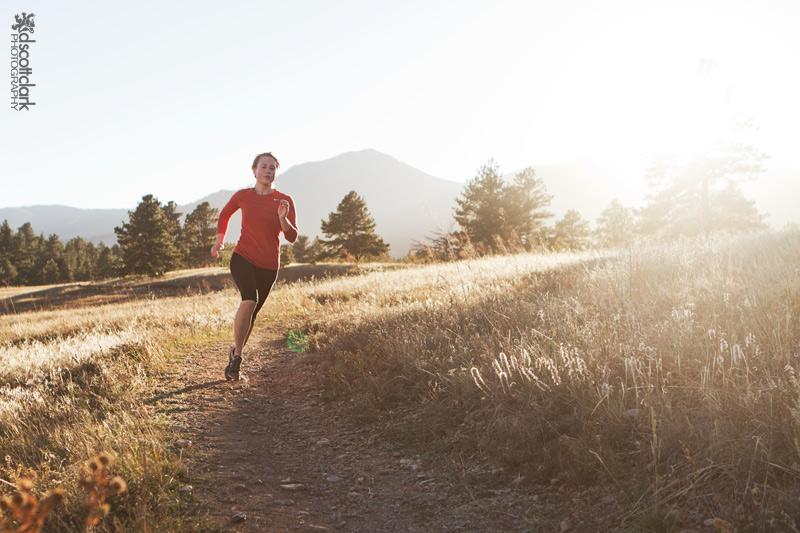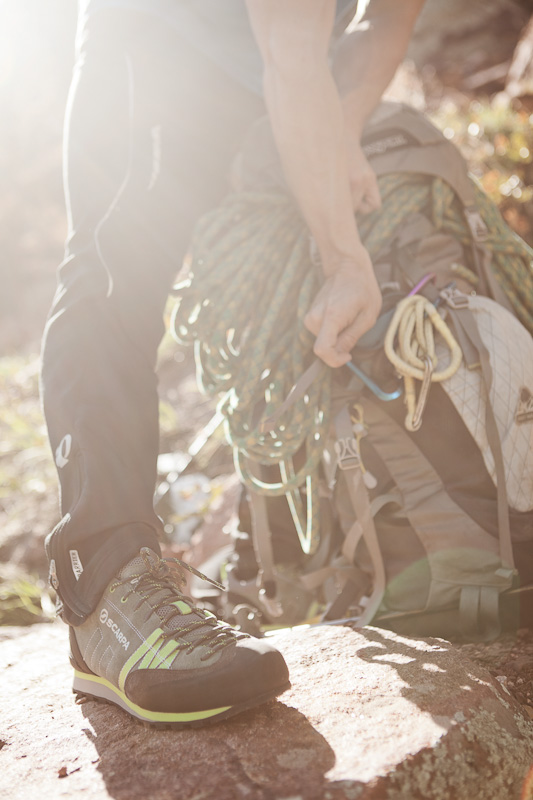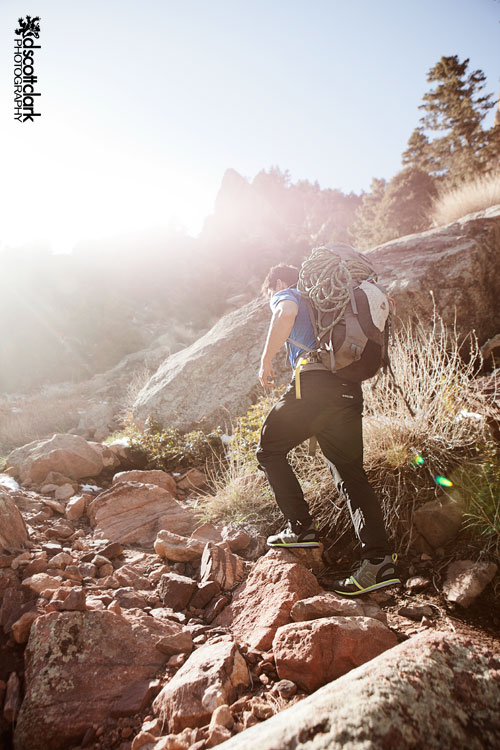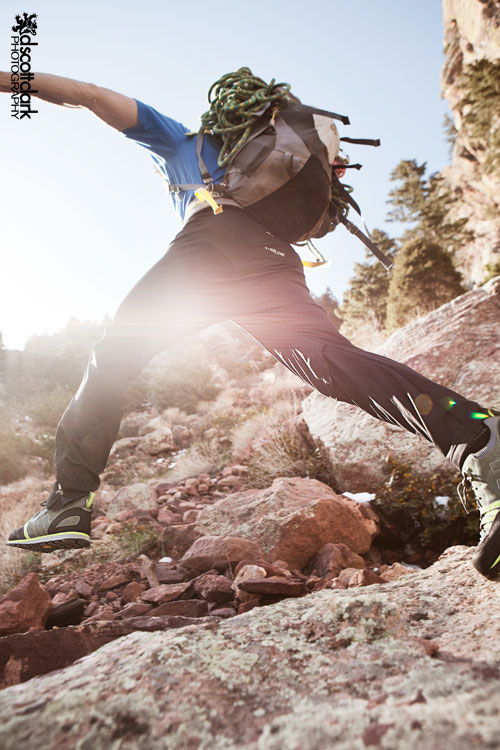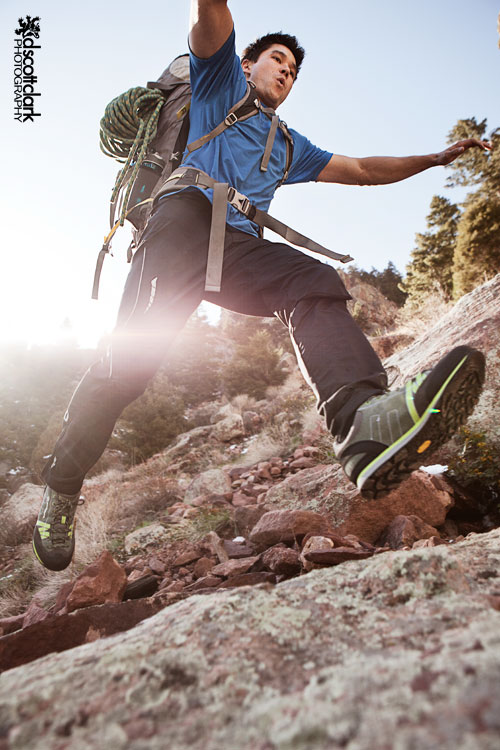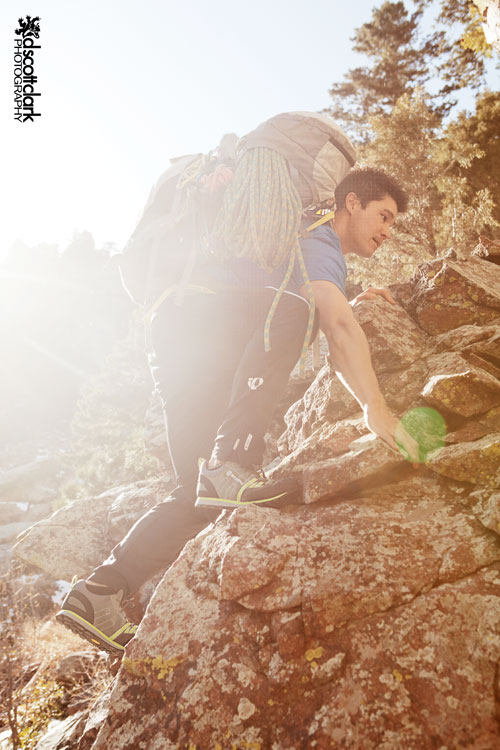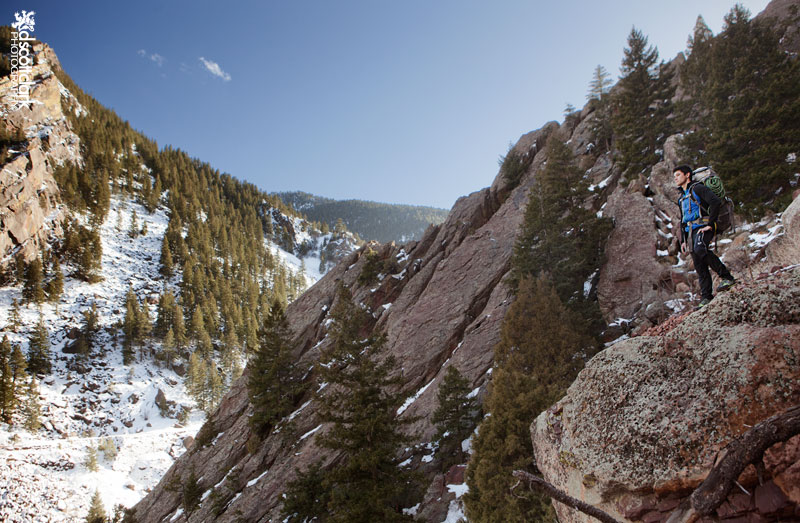Author: D. Scott Clark
Portraits of Deacon Frye
Portraits of Josh White
Yesterday I did a quick portrait shoot with musician Josh White at Madelife, the creative incubator where I work part time as a photography mentor.
It’s Been Cold Here in Boulder
Back from the Fury of Outdoor Retailer
Another OR is over. I rushed to get my new portfolio magazine (take a look!) prepared for the show and skimped on setting up meetings, but the show went well despite my lack of preparation. It was a slow show, so many companies had more time to talk with me. (Many are hurting because of the lack of snow in much of the country).
Now the real work begins, the constant contact after the show. Get companies engaged and make them think of you first when they have photography needs. It’s a balance between not contacting them too soon when they’re swamped with all the other inquiries and not too long when they forget about you.
So…I have work to do. And I leave you with a random photo from last month.
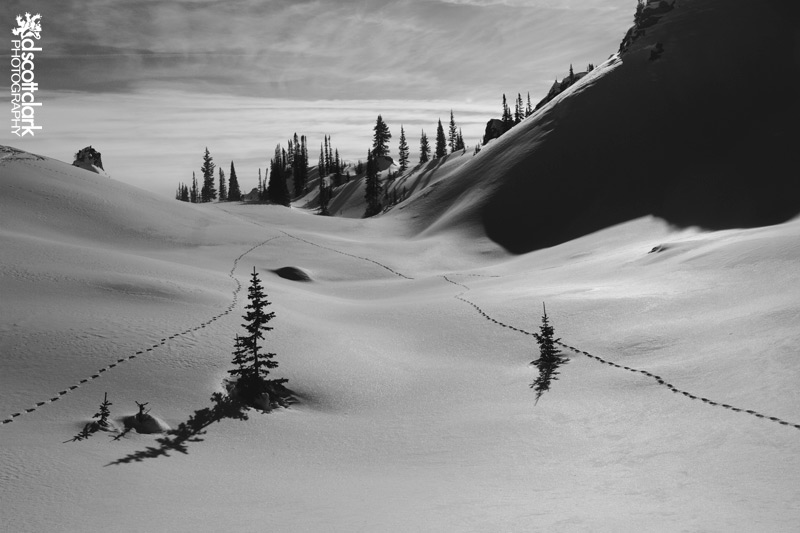 |
| The Crested Butte backcountry on Mt Evans last month when I was out with Donny Roth for Dynafit |
Gear Reviews: Adidas Terrex Fast R Mid GTX – UPDATE!
I originally posted about this shoe back in May without reviewing it thoroughly. The Adidas Terrex Fast R Mid GTX has been my main hiker, adventure approach shoe, and by default, because it is my only GoreTex shoe, my winter/snow boot. I have worn it for a lot of short days, as an approach shoe in Colorado, where approaches to climbs generally take less than 30 minutes. I use it when running around in the snowy streets of Boulder and when going to ski in the mountains. But I hadn’t really used it for it’s main purpose, hiking, until recently.
Side note: I generally don’t like hiking just to hike. I want to be going somewhere. I want to hike to climb, hike to ski, hike to swim in some freezing cold alpine lake. Going hiking for…exercise? I can think of plenty of exercises I would rather do.
One thing that I appreciate about my family is that they’re all active. When we get together for a holiday we never just sit in someone’s house and watch TV. We go hiking or on bike rides. For New Years this year my family went to Reno to my oldest sister’s new place. There is quite a bit of hiking around Reno & Lake Tahoe. There was too little snow for good skiing, and even for snowshoeing. We hiked, everyday, a lot, in many different conditions.
In the week spanning the New Year I put a lot of miles on my Fast R’s. And I’ve never appreciated them more. When I first got them they were too narrow for my oddly shaped wide feet, but now they fit me like a glove, a testament to breaking in your boots. The traction grips on every type of terrain; the Continental Rubber sticky but strong, shows no signs of wear. Walking on uneven ground, aka every trail, your steps feel controlled. I didn’t know about the separated heel that helps to stabilize you on descents until I was looking up reviews of the women’s version for my sister. I didn’t know about it, but it works!
The lacing system took some getting used to, but now that I have it figured out I love it. When I’m just slipping the boot on to go around town in the snow I leave it loose and it’s super comfortable. When I’m ready to get into the thicket I can quickly dial in the perfect fit. You pull the loop, cinch down the plastic tab, and tuck the string into an elastic catch. No boots coming untied, ever.
Whether I’m playing in snow, hiking through the mud, jumping across a creek, I’m never worried about my feet getting wet, and because of the build, the boot breathes incredibly well. Oh, and this boot is LIGHTWEIGHT! I even did some trail running and the mid-high boot didn’t bother me at all.
I’ve been very impressed and even helped get a pair for my sister.
Michael O’Rourke on Free Range (v13) for Mad Rock
In the late spring we had a lot of snow and the runoff caused Boulder Creek to run quite high. We had to build a platform of fallen trees to put the crash pads on over the rushing creek.
This week, it looks like I’m heading up into Cody, Wyoming for an ice climbing adventure with a bunch of great guys. After I’m immediately heading to Outdoor Retailer in Salt Lake City for my biannual networking fest. I’m missing some really amazing snow right now, but I’m excited to climb in Wyoming!
Breckenridge on a Full Moon
 |
| All of the Breckenridge skiable terrain and most of the town in the multishot panorama |
Cover Photo

You’re Welcome
Sometimes It’s Not Perfect
The last couple of months have been great for my adventure needs; I’ve gotten out and done something adventurous every weekend since the end of October! This summer I had been feeling, well, adventureless. I know, I went to Peru and had an epic, but besides that I don’t feel like I did anything really awesome. I got out and climbed around Colorado, and I did get to raft the South Platte river which lightened my spirit quite a bit, but all of that wasn’t enough. Spending two consecutive weekends on Long’s Peak was a great start to what I hope will continue to be an adventurous year.
Last weekend I got out for my dose of adventure, but both jaunts into the wild were less than ideal – I’d even say disappointing.
Besides climbing Dreamweaver at the beginning of November, with zero ice on the route, I haven’t gotten out to ice climb yet this year. Disappointing. Friday I finally got out with Matt Lloyd, excited to get into some good water ice in Vail, but we decided to go to Officer’s Gulch instead, mostly because it’s slightly closer. You can see the Shroud from I-70 and it usually looks quite fat. The approach is a ten minute walk on a flat bike path, about as easy as it gets in Colorado without rapping into the Ouray Ice Park.
The Shroud was not looking particularly fat as we approached. What is usually one very solid slab of blue water ice was nearly two separate pillars of dripping chandelier ice. Dripping. The temperature is flirting with 0ºF and the ice is dripping! Not a little but showering you as you climb, making it almost impossible to look up, soaking your climbing gloves making your fingers unusable, and finally freezing to every part of your outer shell making you an icy coat of armor. You start an ice screw into the chandelier ice and feel it sink hollowly in with little resistance, not inspiring confidence in it’s ability to catch you if you fall. Hanging off your tools with hands that are beyond numb, forearms unbelievably pumped, and feet slipping off the featureless ice you will yourself to continue. It’s easier to go up.
On top of the first vertical section snow gathers on the low angle shelf, your ice tools tear through a layer of unconsolidated ice that starts to avalanche on top of you. You push that aside and get a solid foot, relaxing a bit as you make your way to the second tier of vertical ice. This time, as you swing your ax into the ice it shatters all around, breaking off and exposing the granite beneath. You lightly pick at the ice to create a hole strong enough to hold you but not too deep, but your tool is dull from dry tooling, refusing to sink into the hole. You inch higher, kicking your crampons into columns of ice you could reach both hands around. Your last ice screw is full of ice and won’t start. It’s useless. You have to just push through to the anchors. As you lower back down what you just ascended you think to yourself, “man, I love ice climbing!”
Suffice to say, the conditions of the ice on the Shroud were less than optimal. Matt and I did a couple of laps each, I ran up a mixed route to practice dry tooling, and we headed home. Not a lot of climbing for the hour and half drive.
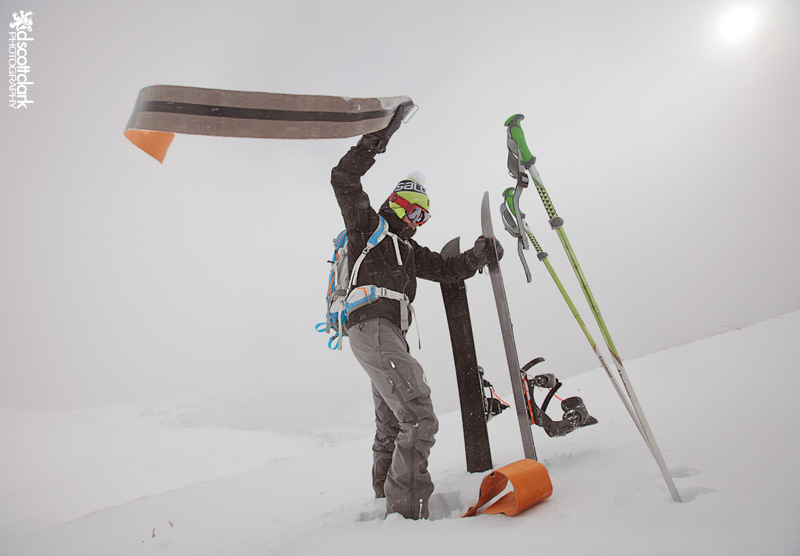 |
| Lee pulls off the skins from his splitboard, preparing to ride down what looked like great snow |
Sunday I head out with my buddy, Lee France, to check out Hoosier Pass for some backcountry skiing. We picked it because we could get there without getting on I-70, which is always choked with traffic on the weekend. Hoosier Pass is just south of Breckenridge on highway 9, and surrounded by 14ers, Lincoln and Quandary. It’s been snowing a decent amount this early season so we thought that in the least it would be skiable. We skin up the trail for two hours debating where to ski. Do we drop over the north side into the bowl or stay below the treeline and ski down to the reservoir on the south side? Lee is a cartographer for National Geographic, and he created a map showing the angles of the faces that would be susceptible to avalanches. The danger above the treeline was considerable so we elected to ski down to the reservoir in the trees. We take two turns in moderately good powder (woo…) and the mountain says, “That’s all you get!” We’re stopped. The snow on low angle will barely slide under my skis. We wallow over to the a steeper gully and every turn is greeted by the equivalent of nails raking down a chalk board: rocks. There’s little more than a couple of inches over some of them. At one point I just am sliding down a granite slab with less than an inch of snow under me. We’ve been beaten. Reluctantly I take my skis off. I believed longer than Lee, he was already stumbling down the mountain, falling in the scree, with his snowboard in his hands. The snow hides the inconsistencies of the route you choose, one step you’re on a rock, your knee against your chest, the next you sink to your waist and fall over. Every step comes with a curse under your breath. This. is. awful.
We put our skins on at the bottom and ready ourselves for another two hour trip back up the mountain to where we started. We’re on residential roads, passing empty, expensive summer cabins. A couple cars pass us. I wanted to stick my thumb out, but I didn’t. This is why we get our right? For the exercise? I think about how heavy my skis and boots are and how badly I want a much lighter Dynafit set up. Every step I take, with each foot I’m dragging an extra 12.5 pounds. I think about how many steps I’ve taken. How much does that mean I’ve lifted today? I don’t want to be – I want to be a machine – but I’m a baby when it comes to carrying weight uphill. I’ll blame it on the 26 years of living at the grand elevation of 900ft or less. I just keep repeating to myself, “this is training. I’m getting fit. This is training. How the hell am I supposed to keep up with the athletes I’m shooting?”
Not every adventure is grand, and not every one is a success. This day was definitely not a success. But on to the next! Also, pray for snow! Do the snow dance. Do something. I want amazeball snow. Maybe I shouldn’t expect that in Colorado.
Running with Rhiannon
At the beginning of November I did a quick running shoot at the Flatiron Vista trail with Rhiannon McClatchey. We met a little bit too late and only got a few shots in before the sun dropped below the Flatirons. Lesson: projected Sunset Times do not take mountains into consideration. But it was a beautiful fall day and I was just happy to be out. I love all the trails in front of the Flatirons. So beautiful.
Gear Review: Scarpa Crux Approach Shoe
Chris Schulte for Five Ten in Lower Dream Canyon
Chris climbed an unnamed arete on the backside of the Freedom Boulder that he’d always loved. It’s a bit of a highball that doesn’t have a great landing, but the problem itself is not too hard.
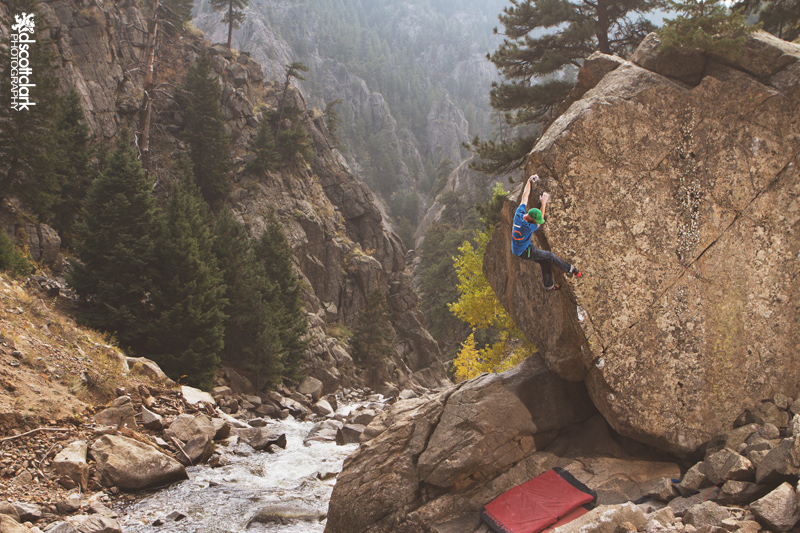 |
| Chris Schulte climbing an arete on the backside of the Freedom Boulder |
We continue up the creek and scramble across wet slab to get to the next boulder, Black Hatchet. The flood waters of the Boulder’s great 100 Year Flood had just started to recede, so the creek was running quite high. Black Hatchet is easier to get to when the creek is frozen, but it’s a beautiful problem with great views up into Upper Dream Canyon.
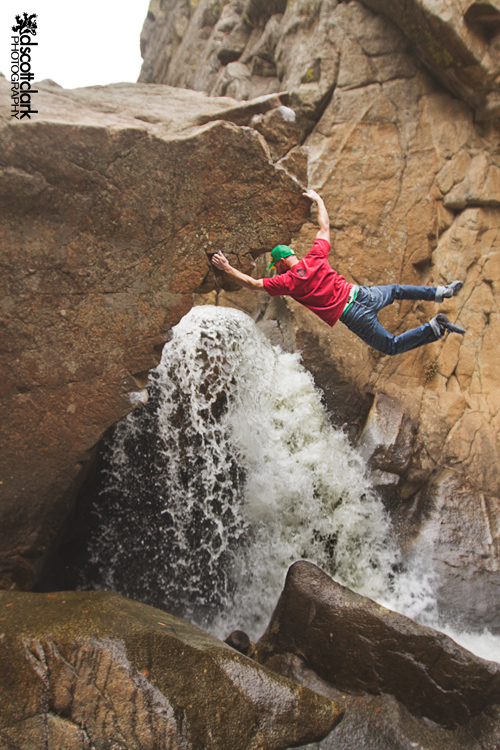 |
| Chris Schulte swinging on Black Hatchet with the high waters after the Boulder Flood roaring beneath him. |
Climbing Out of Climbing Injuries
An overview of some injuries and recoveries:
In 2005 I took close to a 40ft whipper on a sport route at Torrent Falls in Red River Gorge. Somehow in my falling my arm got caught between my knot and my safety knot in the rope. When the smoke had cleared and I was lying limp at the end of the rope, my partner thought me dead. The “loose” loop in the rope had caught and stretched tight enough to squish my right triceps, permanently separating it into two sections connected only by scar tissue.

The dreaded injury that had nothing to do with climbing but keeps you out for months: I was skiing in the trees at Beaver Creek and hit a buried rock that sent me superman-ing into a boulder field. While my brain was screaming “Protect the head”, I stuck my arm out to brace for impact. My right shoulder received such jar that I couldn’t use it to climb for over two months…and I tried. And I kept hurting it. It took nearly six months for my shoulder to heal completely, though I was climbing hard before it did. Lesson: Stop doing stupid things that impact your climbing. Side note: get health insurance!
The Back Breaker
“Onsight it! You can do it! It’s a Jughaul!” Although I was pretty inexperienced at Trad I thought, what the hell, this one is just my style. I jumped on the Kloof in Eldorado canyon, and without thinking about my gear placements or the fact that I should think about my gear placements I started swinging up the overhanging route. I was sport climbing. I had no worries. I got a little bit off route then made a big throw for a hold. “Eh, not good enough” I thought, and I let go. I LET GO! Pop! Pop! In 30 feet I’d placed only two Camalots, and both of them failed. I hit the ground, amazingly on the flat ground between two large rocks that would have wrecked me.


Gear Review: Dynastar Cham 97 – All Mountain Ski
I did recognize one their weaknesses, but I had no idea of the extent: Crud. I got bounced around like a rag doll, precisely because of why I enjoyed them. They were too playful and couldn’t power through rough, choppy, end-of-the-day-on-a-Colorado-powder-day crud. Before last season I got a job selling skis at Boulder Ski Deals. Needless to say, I learned a LOT about skis I never knew before. I had never realized how soft my Maestro’s were until I compared to a lot of skis on the wall.
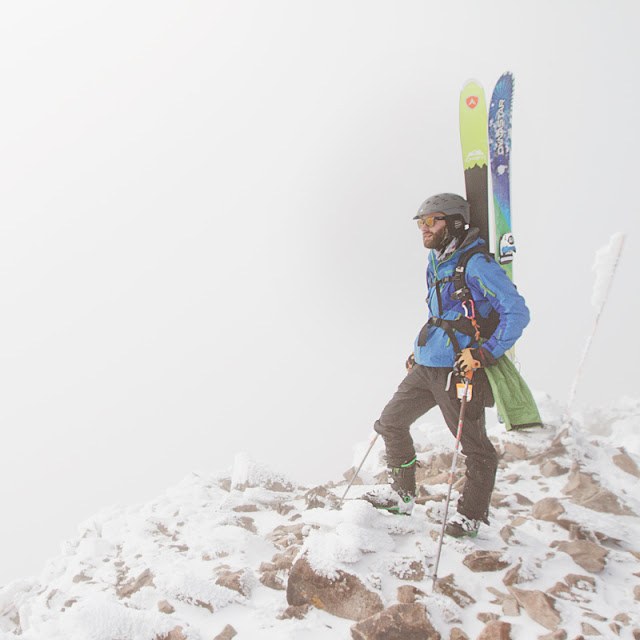 |
| Hiking Alberta Peak at Wolf Creek Ski Area in Southern Colorado with my Cham 97’s on my back |
Dynastar’s Cham 97’s are completely different. They’re incredibly stiff skis, especially compared to my Maestro’s. These are crud blasters that won’t get bounced around by any amount of the rough stuff. They have a unique shape, with a large sidecut, fat tip with lots of rocker, and a flat pin-tail…tail. At 97mm in the waist, 133mm/113mm in the tip/tail and 16m turn radius, these things rip. (Sorry for all the tech talk)
With the 97mm waist and 16mm turn radius, the Cham’s are easy to rollover on groomers. I cannot overstate this, they LOVE to turn! You can make the turn anything you want, from long GS turns to quick slaloms. You’ll feel stable putting it up on edge. The rockered tip gives you easy turn initiation and grips along the full ski. Though, be warned. This is not a beginner’s ski.
Where I’ve really found the Cham 97’s shine is in powder. I’ve never felt a ski handle like this in the deep stuff. If you were out with me when I discovered this you would have heard a lot of “THIS IS AMAZING!” and “WOO HOO!”‘s. The narrower pin-tail stays low in the snow, making it super easy to keep your tips pointed up in the powder, even with your weight more forward. The wide, rockered tips float effortlessly. Making turns in this position is incredibly easy; I felt like I was barely pushing the tails to make grand turns. Skiing the powder was…bouncy. It felt so light and easy to maneuver. In contrast, I always feel like I’m dragging my tails in my Maestro’s.
So, in other words, I love these skis; they are fantastic. But that does come with a caveat or two. Jumping can be uncomfortable. No, scratch that. Landing can be uncomfortable, especially on hardpack. Where the Maestro excels in being springy and playful, the Cham’s are stiff and unforgiving. The extent to which this matters depends on your skiing style and preference. Secondly, the Cham’s are heavy. Weighing in at over 10lbs for both skis, you will think twice about making these part of your backcountry set up. They do come in a High Mountain version that reduces the weight by 25% but sacrifices some of the inbounds performance (this only really matters if you plan on skiing them inbounds).
Not surprisingly, the Dynastar Cham 97 won Outside Magazine’s Gear of the Year award in 2013. If you like to charge, ski the entire mountain, and want a ski that can do it all, I highly recommend this one.
